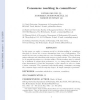Free Online Productivity Tools
i2Speak
i2Symbol
i2OCR
iTex2Img
iWeb2Print
iWeb2Shot
i2Type
iPdf2Split
iPdf2Merge
i2Bopomofo
i2Arabic
i2Style
i2Image
i2PDF
iLatex2Rtf
Sci2ools
EOR
2007
2007
Consensus reaching in committees
In this paper, we apply a consensus model to decision-making in committees that have to choose one or more alternatives from a set of alternatives. The model does not use a voting rule nor a set of winning coalitions. Every decision maker evaluates each alternative with respect to given criteria. The criteria may be of unequal importance to a decision maker. Decision makers may be advised by a chairman to adjust their preferences, i.e., to change their evaluation of some alternative(s) or/and the importance of the criteria, in order to obtain a better consensus. The consensus result should satisfy constraints concerning the consensus degree and the majority degree. A simple example is presented.
| Added | 13 Dec 2010 |
| Updated | 13 Dec 2010 |
| Type | Journal |
| Year | 2007 |
| Where | EOR |
| Authors | Patrik Eklund, Agnieszka Rusinowska, Harrie C. M. de Swart |
Comments (0)

